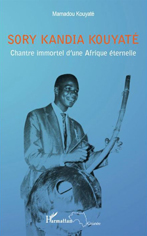Sory Kandia Kouyate
- Gerald Van Waes
- Oct 6, 2016
- 3 min read

Sterns Music Sory Kandia Kouyate :
La voix de la revolution (GU/ML,1961-1973,re.2012)***°
I also would like to list this release from last year; still I hardly had enough time for a proper in-depth review. To make it brief and complete enough, I will resume some background info taken from the booklet and will describe what to expect on the CDs.
At very young age it was already clear how talented Sory Kandia was in discovering and playing certain musical instruments. Therefore his father (a koni player and known to be a "master of the word") started to teach him everything he knew from the Mandig traditions at the time he was 7 years old. The freshly educated artist quickly joined the royal court of Mamou, where his voice was heard ever since. On request of his father, he was given one week off to visit Konakry to learn to know the local music lovers. His appearance made him so popular they had to extend this visit. At that time he bought a Spanish guitar. One day, when the microphone fell out, he sung his heart out to everyone's amazement. The public recognised him as a voice of power, a gifted voice, as the kind of voices that are recognised to be magical because it has the quality to change destinies of people, just like those from shamans. Kandja Kouate assembled his own 12-headed traditional ensemble. Around the same time, Guinean artist Keita Fodéba founded Ballets Africains, which he decided to join while bringing in to the group new local rural and urban tunes. In 1956, he was invited to France, where he recorded his first album (on Vogue Rec.), after which he toured further around the world, before returning to the Ballets. In Australia he had performed with Paul Robeson where they compared him with a flamenco singer. In 1964 he cooperated with the Ballet National Djoliba. He also loved to work with Malian kora player Sidikiba Diabaté with whom he recorded three LP’s. Under influence of president Ahmed Sékou Touré the Ensemble Instrumental et Choral de la Voix de la Revolucion was placed under Kandia’s directorship, with a mission to have the people heard the voice of the land. In 1974 he visited the Islamic cities as a good Muslim was supposed to do. In 1977, the artist, while touring, was felt by a stroke and passed away at age 44 only.
The box consists of two very different compilations.
The first CD is my favourite and is the traditional one. Most tracks show the beautiful kora-playing which accompanies Sory Kandia’s singing very rhythmically.
On the first part of the first track his singing has something of Arabic spiritual singing, which changes thoroughly into a more wordy African story-telling style. You can hear that his voice is able to carry out emotions. At times you can easily compare his singing to a flamenco singer (especially on track 4 & 7), at some other stage it shows he has the power of an operatic singer, but sometimes he simply sings loud (track 9). The accompaniment on these tracks is by kora (Sidikiba Diabaté), in combination with a few other African instruments like ngoni and bala (Djéli Soty Kouyaté), or acoustic guitar (which is played more in a kora-way as usual, like on track 7, a track where we can also hear some responding girl singers). The group singing harmonies on track 8 are also worth mentioning.
On the second CD other instruments like keyboards and sax were given a separate mention in the booklet (Keletigui Traoré). On this CD we hear mostly crossover styles, or dance music styles (like samba), accompanied by a brass orchestra or just played with electric guitar and sax. Here it is where Kanja Kouatés voice sound a bit more operatic (like Placido Domingo perhaps), but more often his voice does not come over as powerful as as on CD1 with a traditional or smaller ensemble. The contributions on the electric guitar are also interesting to hear. There are also some African instruments that come trough. And there are also more African group responses and singers involved, singing soulfully, while this is rooted in enterainment but still shows combinations with African styles, this new combination still does not feel so essential compared to the rooted creativity in the traditional based music played and assembled on the first CD.
















































Comments